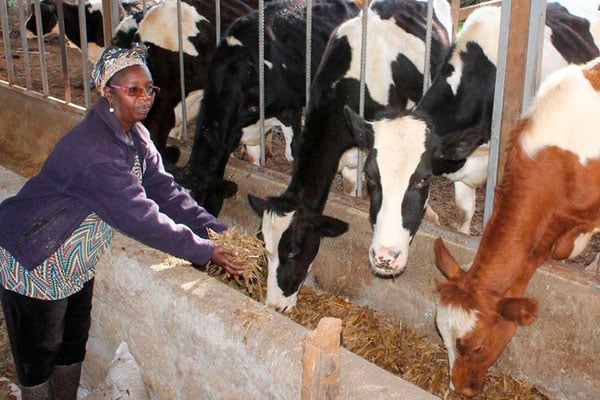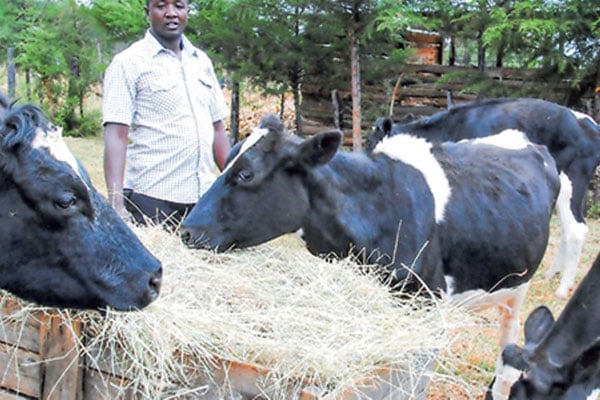Prime
Fortune in fodder farming

Josphine Kirui feeds her zero-grazing dairy cows silage. The use of silage as a feed helps farmers to build climate resilience. Photo/Shabibah Nakirigya
What you need to know:
- Fodder grass is prone to pests such as aphids, cutworms, and diseases such as root rot, stemphylium leaf spot. Continuous application of farmyard manure in the field helps to improve soil fertility, structure texture and increase the yields.
One way to make a living as a farmer is to grow grass for sale to livestock keepers. Normally animals such as sheep, goats, and cattle graze in the bush eating the grass that there is for them to eat.
Grazing ground for the animals usually supports many types of grass species and not all farmers really take the trouble to find out which grass species are cereals or legumes and their nutritive value to the grazing animals.
Some people do not even know that grass is a crop that can be grown carefully and sold for money.
Money in growing fodder
Adrian Ddumba, animal technician at Mukono Zonal Agricultural Research Development Institute (MUZARDI) Kamenyamiggo Satellite, told Seeds of Gold, “For people who don’t keep livestock and they have some land it is possible for them to make money just by growing grass and selling it to the farmers who keep animals, particularly in urban settings. It is one of the most lucrative occupations because growing grass does not require a lot of inputs.”
“Compare a farmer growing climate smart improved forages such as bracharia toledo, bracharia mulato or bracharia cayman on a hectare of land and another one growing crops like beans and groundnuts. In only eight to 10 weeks after planting the Bracharia farmer can sell his product but the farmer growing beans or groundnuts will have to wait several weeks more. The farmer growing grass has fewer weeding issues, if any, and his market is almost assured because there are very many farmers and trading companies out there that need fodder, especially during long droughts.”

Brian Sindikubwabo (left) and Jonathan Nsimbe arrange bags of silage and hay produced by Radiant Farm Uganda Ltd. Photo/Michael J Ssali
Agronomy
Ddumba says harvesting for the grass species takes place after 60 days and it can be fed to the animals green or conserved as hay or silage.
He said hybrid bracharia has improved tolerance to drought, and grows fast. He further said it has good yields amounting to up to 10 or even 40 tonnes per hectare and 100-140 kg of seed per hectare annually. He also said it has fast recovery after harvesting and very good storage quality.
People who want to become grass farmers can consult their agricultural services extension officers or agricultural research institutes for guidance regarding grassland type where to get it from and the means of propagation.
High yielding varieties
Ddumba who was stationed at the Naro stall in the recently concluded PEWOSA Agri-Business Fair in Masaka also displayed Improved Elephant Grass (Packchong). He said the grass has good yields amounting to 20 or 35 tonness per hectare per year.
Other types of fodder grass that can be farmed include Improved Guinea Grass (Pennisetum purpureum), Rhodes grass, and Kikuyu grass among many others.
“You have to bear in mind that once the grass has been planted all that the farmer does for the rest of the time is to keep harvesting and selling,” Ddumba said. “And since the soil is all covered up with the grass growing on it there is very minimal soil erosion by either wind or running water.”
Management
Control of weeds during the initial crop development is key to good fodder grass growth since weeds compete for space, light, and moisture and in some cases harbour pests.
Early weed control helps to reduce the cost of production before the weeds have fully developed.
Fodder grass is prone to pests such as aphids, cutworms, and diseases such as root rot, stemphylium leaf spot. Continuous application of farmyard manure in the field helps to improve soil fertility, structure texture and increase the yields.

Ankson Owesigire, Quality Assurence Officer at Radiant Farm Uganda Ltd (standing) explains to farmers about the importance of preparing for drought periods. Photo/Michael J Ssali
Harvesting
In most cases, farmers usually have good fodder grass establishment, a first good harvest but fail to get the second one due to lack of good management practices especially during harvesting.
It happens when the farmer allows the animals to graze by themselves and pull out young fodder grass.
Most fodder grass/pasture is harvested mostly when it’s 50 percent flowering since the protein content is high. This also allows the plants to build up better roots and enables stronger and faster recovery, which leads to the proper establishment of the stand.
Harvesting can be done using a sickle or machete to a stubble height of about 5cm above the ground. This allows the plant to regenerate as long as there is adequate moisture.
Lucerne is cut and fed while green after a little wilting to avoid bloating. It can also be preserved as hay for future use. The crop can last to about 3-4 years under good management.
Radiant Farm Uganda Ltd
Growing grass for sale to livestock keepers is an idea that large scale farmers like Radiant Farm Uganda Ltd conceived way back in 2019. Located in Nangabwami Village, Kikandwa Sub-county, Mityana District, Radiant Farm Uganda Ltd has devoted more than half a square mile to growing fodder grass and selling hay and silage to livestock keepers.
Brian Sindikubwabo the company’s operational manager revealed to Seeds of Gold that the concept actually developed after a study spearheaded by Emmanuel Muwazi, the managing director of Radiant Farm Uganda Ltd, before the onset of Covid-19.
“We observed a lot of farmers in Kampala and nearby communities were feeding their animals on grass cut from the Lubigi Swamp and banana peelings collected from rubbish bins, which was not really healthy for the animals,” Sindikubwabo stated.
“That grass was contaminated with liver fluke eggs which cause illness to the animals and some hard metals from sewage outflow that could not be processed by animal bodies. The other risk is that the hard metals can be passed on into milk and meat rendering them unfit for human consumption.”
Sindikubwabo who is a trained animal nutritionist said banana peelings collected from rubbish bins often are contaminated with plastic material, sharp objects, and various poisonous objects apart from being nutritionally lacking as animal feed.

Adrian Ddungu (left) talks to farmers about fodder grass growing.PHOTO/Michael J Ssali
Jonathan Nsimbe, the product access officer at Radiant Farm Uganda Ltd, said the company has many customers and gets orders from farmers in many districts across the country. “We make hay from both legumes and cereals,” he said. He gave examples of legumes as Caliandrah, which is a form of tree often planted as a fence around farms, Green leaf desmodium, which is a climber plant, Glayisiline, which is also a climber, Alpha Luffa and Lablab and Mukuna which are creepers and climbers.
He said legumes are rich in protein. He named cereals grown at the farm as Chrolise Gayana, Molato, and Panikamu/ mukonzikonzi. He said cereals are rich in energy and carbohydrates. He further said to make silage they use mainly maize, napier grass (ebisagazi) and sorghum.
Brian told Seeds of Gold, “Silage making means cutting the crops when they are fully grown but still green, then laid in a pit and pressed down hard and covered with a plastic sheet and buried to facilitate fermenting.” He said hay making largely depends on the weather. The grass should dry quickly and tied up without losing much leaf for feeding livestock during rain short age periods when grass is scarce.
“It is not hard to understand why it is so paying to invest in silage and hay making,” says Brian.
“Just as poultry farmers in urban centres buy feeds and still make profit, so can an urban cattle keeper who buys hay and silage. We have always ensured that all the time there is hay and silage ready for sale. And we are really encouraged by the big number of orders we are getting from far and wide across the country.”




